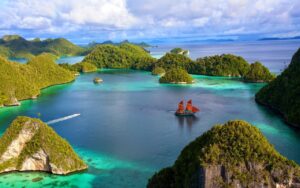South America’s first digital nomad village is coming to Brazil
4 min readBrazil is gearing up to showcase the best of its unique biomes and ecotourism experiences.
With world-class beaches, swathes of Amazon rainforest, history-packed cities and off-track wilderness plains, Brazil’s colossal landmass packs a staggering diversity of nature, culture and adventure across its 8,000 kilometres of coastline and six distinct biomes.
According to Bruno Reis, International Marketing Director at Embratur, tourism in the most biodiverse country in the world is unique: “There are types of experiences you can only have in Brazil.”
From January to September 2024, over 741,000 tourists from Europe visited Brazil. While the remarkable beauty of this South American country is no secret, it is no surprise that Brazil wants to protect it through authentic and sustainable travel experiences.
It’s especially appealing for those wanting to get beyond the coastal hotspots and into Brazil’s central, untouched rural spread.
Must-see Brazil: Where to go if you’re a first-time visitor
The sheer size of Brazil’s land mass is overwhelming – where do you even begin mapping out where to go in its 8.5 million square kilometres?
If you are visiting for the first time, Reis highlights several must-see destinations to give you a taste of the country’s staggering coast to peak natural beauty, cultural richness and the iconic attractions.
Start in the pulsating coastal city of Rio de Janeiro and hit the golden sand beaches backed by jagged peaks. Head to the famed Ipanema for a dazzling stretch of picture-perfect coastline or Copacabana after sundown. Head to the Christ the Redeemer statue on a trail through the Tijuca Forest National Park and feel like you’ve left the city behind.
Double up on the world icons and head inland to Iguazu Falls, the mega waterfall located on the border between Brazil and Argentina. Its cascades draw the crowds for a reason: it’s one of the Seven New Natural Wonders of the Modern World.
North of Rio, city hop to the colourful UNESCO Historic Centre of Salvador de Bahia and wander its sloped cobblestoned streets lined with colourful colonial-era houses. Given its slave trading history, it is also an important centre of Afro-Brazilian identity and culture.
Brazil is synonymous with the Amazon Rainforest, so get to the gateway of Manaus for local living, treks and boat trips through the incredible biodiversity of the world’s largest tropical rainforest – half of which is in Brazil!
Sustainable and regenerative travel: Brazil’s core focus
In national parks and bio reserves, wetlands and coastal set heritage towns and cities, “we are talking about regenerative travel to Brazil and how tourists can support and protect our biomes,” says Reis.
It can be as simple as venturing beyond the iconic sites on more adventurous trips.
North of the capital, Brasília, you can leave the metropolis and choose from dozens of walking trails in Chapada dos Veadeiros National Park, passing the mighty caverns and stunning waterfall baths that make up this rugged forested rock landscape and protected UNESCO Natural World Heritage area.
“Brazil has a lot of UNESCO heritage sites, so maybe a second trip to see one would be a great idea,” adds Reis.
Visit the Pantanal: The world’s largest tropical wetland
Brazil’s focal area for regenerative tourism in 2025 is the Pantanal. It’s a star state for those wanting to see a pristine patch of the country. It encompasses the entire state of Mato Grosso do Sul, close to the Bolivia and Paraguay borders.
The world’s largest tropical wetland, it’s a haven for birdwatching and spotting rare flora and fauna.
“You should go to Pantanal to live Brazilian Safari…it offers unparalleled wildlife viewing, including jaguars, capybaras, and countless bird species. The region also offers a unique opportunity to experience one of the world’s most biodiverse ecosystems in a sustainable way,” says Reis.
The Pantanal’s town of Bonito is a great starting point, surrounded by glass blue rivers you can float down, the otherworldly Abismo Anhuma cave that you have to abseil 72 metres into, waterfalls you can descend on rappelling circuits and backcountry you can traverse on horseback.
It’s no wonder “Bonito won several prizes of ecotourism in Brazil,” Reis adds.
Brazil: A destination for all travellers
Beyond the deep dive into nature and adventure, Brazil is pushing travel experiences to diverse groups, from cultural deep dives with Afro tourism to LGBTQ+ tourism and indulgent luxury retreats.
Across its 26 states, 74 national parks, six biomes and 8,000 kilometres of coastline, Reis explains that Brazil is trying to attract “all the kinds of tourists who want to protect nature and be in contact with local communities in Brazil. I’m sure everyone will have a lifetime experience down there.”



